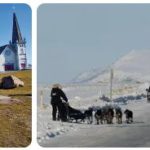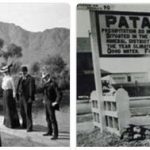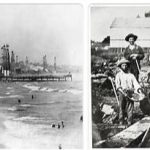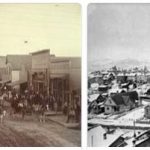Alaska is the largest US state – in fact it is larger than all but 18 countries of the world, and about 1/5 of the total land area of 48 contiguous states.
Since the Aleutian Islands traverse 180 degree longitude lines, Alaska is actually the westernmost, northernmost, and easternmost state! It’s rugged and besides glaciers, countless rivers and lakes, majestic mountain peaks, some active volcanoes, and almost 34,000 miles of tidal coastline. North America’s highest peak, Mt. McKinley (or Denali) at 20,320 ft., located in Alaska. 65% of the state’s land is owned and operated by the US federal government. Alaska owns about 25% and 10% is owned by indigenous people, leaving less than 1% of the land in private hands.
Initially settled by people who crossed the Bering Isthmus, Alaska later became inhabited by Inupiaq, Inuit and Yupik Eskimos, Aleuts, and a variety of Native American groups. Most of the original people of the Americas are thought to have traveled this route from Asia. and then continued further south. In 1725 Peter the Great of Russia sent Vitus Bering to explore the North Pacific. He sailed through what we now call the Bering Strait in 1728. Nearly 50 years later Juan Pérez of Spain and James Cook of England also explored the same area.
The first step-native settlement, Nikolaevsk, was built on Kodiak Island in 1784. Originally founded as an otter-fur sea post, it was never profitable due to high transportation costs.
In 1867, the British North America Act established a monarchical state in Canada. Then US Secretary of State William Seward urged his government to quickly buy Alaska from Russia for a bargain price of $7.2 million – or about 2 cents an acre. See canceled check here. On October 18, 1867, the American flag was raised over Alaska and this is commemorated as Alaska Day. Widely derided as “Seward’s Folly” or “Seward’s Refrigerator”, the purchase was thought to be a waste of money, but proved to be one of the best real estate deals ever.
When gold was discovered in Alaska, approximately 100,000 people eventually participated in the Klondike Gold Rush (1897-1901). The Northwest Mounted Police strictly controlled the miners and their activities, and that the ‘Gold Rush’ is regarded as the most organized and peaceful in history. The writer Jack London took part, and many of his books were influenced by the experience.
Alaska was granted US territorial status in 1912 and entered the United States on January 3, 1959 as the 49th state, with its capital in Juneau.
Alaska timeline
1500s – 1600s
- (1578) Cossack Leader Yermak Timofyef traveled eastward from Russia across the steppes
- (1639) Cossack horsemen arrived; built the first Russian village
1700s
- (1725) Vitus Bering explored the Northwest coast; established Russia claim
- (1728) Bering sailed through the Bering Strait
- (1741) First Russian ships arrived; animal trappers started the fur trade
- (1774) Juan Pérez discovered Prince of Wales Island, Sound of Dixon
- (1784) First white settlement established at Three Saints Bay
1800s
- (1802) Tlinglit Indians destroyed the Russian fort at Staraya Sitka
- (1804) Russians attacked the Kiksadi fort on the Indian river; Russians lost
- (1847) Yukon Fort established
- (1853) Russian explorers found oil in Cook’s Inlet
- (1857) Coal mining started in Coal Harbor
- (1861) Gold discovered in the Sticaine River
- (1867) Russia sold (modern) Alaska to the United States for $7.2 million (about 2 cents per acre)
- (1868) Alaska designated Department of Alaska
- (1869) Sitka Times, first Alaskan newspaper, published
- (1872) Gold discovered near Sitka
- (1874) George Halt first white man to cross the Chilkoot Pass in search of gold
- (1876) Gold discovered south of Juneau
- (1882) First commercial herring fishing began
- (1884) Steamboats began to bring tourists
- (1888) More than 60,000 came looking for gold
- (1897 – 1900) Klondike Gold Rush occurred








